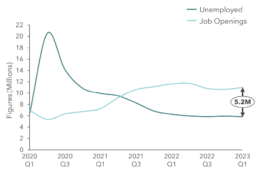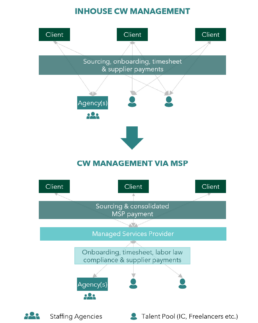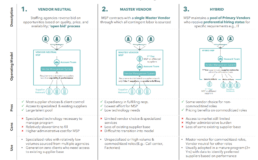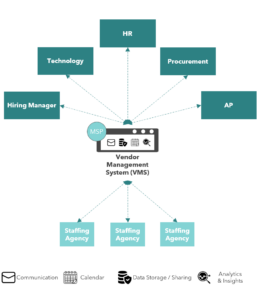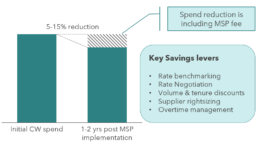The Paradox of Talent
30 employees were laid off every minute in the US in 2022(1). 87% of CEOs and CFOs believe the world economy is already in or about to enter a recession. In preparation for the downturn, most businesses are
planning a reduction in workforce(2).
However, at the same time, a skills shortage continues. 77% of employers expect difficulty in filling their talent needs in 2023!(2). Firms realize the need for retaining (and even hiring!) skilled talent to develop
and sustain a competitive advantage in the marketplace.
Such a dynamic business environment has led to a paradox of simultaneous labor surplus & shortage. This scenario creates an uncertain labor market in which businesses need to adopt an agile &
flexible talent strategy that can be quickly re-scaled and re-skilled as needed.
Exhibit 1. US Staffing Industry(3)
Businesses are responding by building robust contingent workforce programs that can provide the needed skillsets at scale, with the added benefit of flexibility. It is not surprising that 83% of executives worldwide
use contingent and seasonal workers today!(4). This on-demand workforce provides the agility needed to swiftly change the scale of operations, enter new geographies, and deploy new skills.
Managing the Contingent Workforce
Historically, contingent worker programs have been managed directly by hiring managers or through multiple master vendors and/or staffing agencies resulting in cumbersome recruiting and management
processes. Even those with established MSP programs are often unable to tap into MSP’s full potential due to misaligned objectives, program bypass or mismatch between client needs and MSP capabilities. The fragmented approach to contingent workforce sourcing and management or ineffective MSP program implementation has led to several challenges:
- Lack of Workforce Strategy
Only 23% of organizations have a contingent workforce strategy despite most reporting that contingent workers comprise more than 40% of their workforce(5). An integrated contingent workforce strategy helps identify the roles suitable for contingent workers, brings forward expected challenges in leveraging this temporary workforce and helps activate internal & external support structures. - High Workforce Costs
Most hiring managers end up paying higher than the market rates due to lack of current market information, fragmented process ownership and underutilization of combined bargaining power of the enterprise. A few firms do attempt to build rate cards and establish processes to ensure these rate cards are enforced. However, even such organizations struggle with rogue/maverick spend. Such spend occurs primarily due to managers bypassing processes or directly fulfilling their staffing
needs from:
i. Unvetted staffing suppliers with no existing contracts, or;
ii. Inappropriate suppliers for the type of worker sourced - Lack of Workforce Visibility
Due to the fragmented nature of extended workforce programs or MSP program bypasses, there are instances where contingent workers are hired under the guise of consultants or statement-of-work resources who are paid significantly higher markups. - Non-Compliance with Local Regulations
In California, 9 out of 10 employers inspected in 2017–2018 were found to be non-compliant with the state’s laws regarding misclassification(6). The complex and dynamic nature of labor laws, especially in the US, makes employee misclassification a significant risk, especially in a contingent workforce program that regularly employs independent contractors. - Limited Access to Talent
The ongoing global talent shortage has impacted the contingent workforce industry as well. Limited local supply of needed skillsets, coupled with constrained access to remote talent pools, limits an organization’s ability to source the right talent, at the right price, within the right time frame.
Exhibit 2. US Job Openings vs Unemployed Individuals(7)
The Role of an MSP
Organizations are now recognizing the limitations in their workforce programs, so are making a concerted effort to develop a contingent workforce strategy, consolidate their master vendors/staffing agencies, and extract maximum benefits from the program.
While many organizations explore the route of establishing their first MSP programs, the uncertain business conditions also call for a revisit of the pre-existing MSP programs. MSPs are no longer mere staffing desks – they are strategic advisors and partners that must remain flexible to meet evolving organizational needs.
The right MSP should help develop an integrated contingent workforce strategy, negotiate competitive rates, curtail rogue spend, widen the talent pool, ensure timely availability of talent and ensure compliance with labor laws on an ongoing basis.
Exhibit 3. Role of an MSP
Finding The Right MSP
Selecting the right MSP has its challenges due to the complex processes, requirements & technological limitations of various MSPs.
Several firms struggle with:
- Defining in-depth requirements
The choice of an MSP is highly contingent on the specific minimum requirements for:
• Skillsets needed – Identifying all types of talent that will be sourced, frequency of need, and average tenure of sourced talent.
• Target State Design: Engaging an MSP without a future state CW procure-to-pay process leads to difficulties in implementation and driving change. Fleshing out the future state processes ensures that
all stakeholders and requirements have been thought through and the MSP will not cause any surprises.
• Special End User Needs: Most organizations have a few end-users with unique requirements (E.g., specific language needs) that must be included in the MSP selection since these requirements may not
be easily fulfilled.
• Worker On/Offboarding requirements – Establishment of various on/off-boarding process owners, as part of the future target state design. Specification of minimum background check requirements
should also be included.
• Invoicing Model – Determination of who will ultimately pay the staffing agencies. Identifying the level of consolidation of staffing agency invoices (company level vs. subsidiary level). - Choosing the right operating model
MSPs can operate in various formats. Choosing the right model is a pivotal decision that dictates whether the MSP can drive the benefits expected out of it. The choice of a model is broadly dictated by:
✓ Nature of roles sourced: white-collar vs blue collar, IT vs non-IT
✓ MSP program maturity: Generation zero vs. already existent MSP
✓ Total spend & number of roles
Exhibit 4. Potential Operating Models
3. Ill-defined Objectives
Organizations typically have pre-defined expectations of cost savings, process efficiencies, access to wider talent pool, accurate worker classification, compliance with labor laws, technology management, etc. Clearly prioritizing these goals helps MSPs propose solutions catering to
those objectives. Lack of clear expectations from an MSP can result in the MSP becoming a cost overhead instead of delivering tangible incremental value. Having too many goals can also lead to sub-par delivery due to the, sometimes conflicting, nature of these objectives (savings vs. reduction in time-to-fill).
4. Complex Change Management
Change management can get particularly tricky due to the plethora of stakeholders involved and the lack of clarity/conviction around what the MSP can bring to the table. Many users may fear loss of access to their talent pool when an MSP comes in. Hesitation from such groups leads to program non-compliance and ultimately failure. A successful change management effort requires:
✓ Involvement of end-users in selection phase
✓ Continuous ongoing education about the MSP’s value
✓ Alleviation of concerns of end users and P2P process owners
✓ Phased implementation to test and internalize new processes
5. MSP’s network with suppliers of interest
As MSPs have specialized relations with staffing agencies in specific industries, it is important to evaluate their network in your industry and domain. Lack of enough suppliers, in the requisite industry, is a common reason for unfilled or delayed requisitions. It is also important to uncover and mitigate the risk of the MSP having a preferred arrangement with a competitor in your industry, especially for hard-to-find talent.
6. MSP’s experience with necessary tooling
All MSP programs require a Vendor Management System (VMS) as the underlying centralized system-of-record and workflow tool. This cloud-based enterprise software platform enables firms to control the process of procuring and managing its contingent workforce. The role of a VMS is that of a facilitator, to streamline and automate contingent workforce management processes. To get the most out of an MSP program, it is ideal to select an MSP with prior experience and partnership with the selected VMS. This ensures that common VMS implementation pitfalls are avoided, and the implementation is fast-tracked through use of ready to plug in modules.
Maximizing Benefits
While there are several benefits available through an MSP partner,
capturing these benefits requires a proactive benefits realization effort.
Such efforts should focus on maximizing:
- Access to Global Talent Pool
The current macroeconomic environment is highly uncertain with simultaneous layoffs & skilled labor shortage. While there is surplus labor in certain sectors due to layoffs, finding highly skilled workers in other sectors remains a challenge. A world class MSP provides access to not only to local talent, but also to global talent pools through network of its suppliers and sister staffing agencies.
Exhibit 5. Role of a VMS
2. Reduction in Contingent Workforce Spend
A new MSP program can typically reduce contingent workforce spend by 10%+ in the first two years of implementation. Early gains can be captured through rate card implementation, suppler consolidation and process efficiency gains. Post initial savings, controls and transparency needs to be set up to ensure the MSP delivers continuous cost control and competitive rates.
3. Greater Regulatory Compliance
MSPs re-engineer processes to ingrain compliance in every step of the procure-to-pay process through the VMS. They may also provide dedicated Independent Contractor (IC) compliance services to mitigate worker misclassification. MSPs maintain local legal teams that monitor and constantly update clients on regulatory changes and ensure that clients fulfil all regulatory requirements.
4. Enhanced Talent Management
One of the most important benefits a good MSP offers is access to workforce data and insights. It provides complete visibility into resource level as well as agency level performance. An MSP establishes the right metrics and SLAs by which supplier performance is measured and thereby helps identify star performers. These metrics can then be used to rationalize suppliers and establish preferred suppliers based on measured performance rather than managerial preferences.
Exhibit 6. Key Savings Levers
5. Future readiness
MSPs continually experiment with newer methodologies to source the right talent at the right price for their clients. Most MSPs have now extended their offering to include:
i. Direct Sourcing:
Involves eliminating middle-men such as staffing agencies and building talent pools that a company may directly tap into to fulfil its talent needs. It helps bypass the heavy markups staffing agencies charge for sourcing the required talent.
ii. Statement-of-Work (SoW) Management:
MSPs are increasingly taking over the sourcing, on-going management and invoicing of deliverable based workers/firms. It provides better cost controls due to implementation of rate cards and helps with management of milestones and deliverables
In Conclusion..
The uncertain and dynamic economic environment has elevated the need of maintaining an adaptive workforce that can be re-skilled and re-scaled as and when needed. A robust contingent workforce program is a pre-requisite for building such an adaptive capability.
Care must be taken in selecting your MSP, the operating model, the right VMS, the financial construct with aligned incentives, internal policies, resourcing processes, analytics and controls. The right MSP can help deliver on your workforce strategy. However, it requires a dedicated benefits realization effort to ensure that you get the right talent, at the right time, and price.
- DemandSage
- Mercer 2023 Executive Outlook Study
- SIA US Staffing Industry Forecast
- Oxford Economy’s Workforce 2020’s survey
- Everest Group Survey (2021)
- National Employment Law Project – 2020
- US Bureau of Labor Statistics

